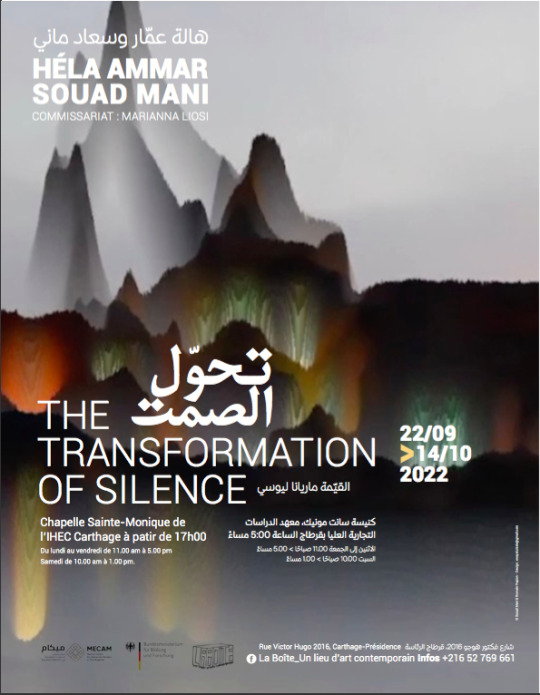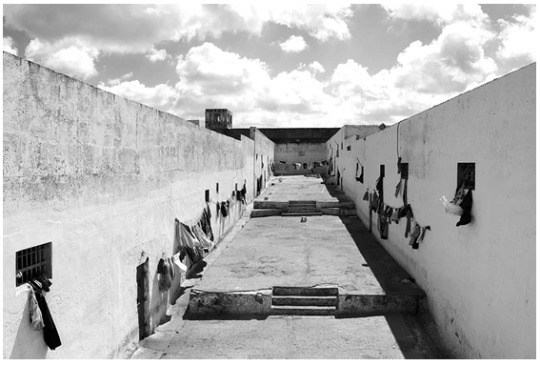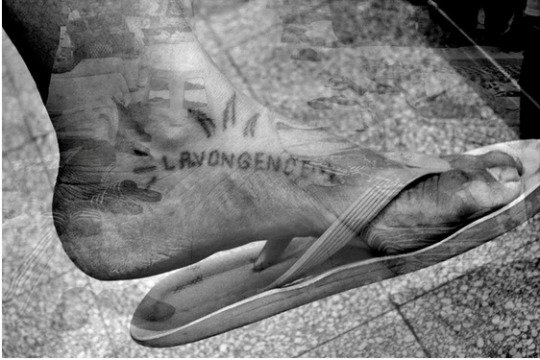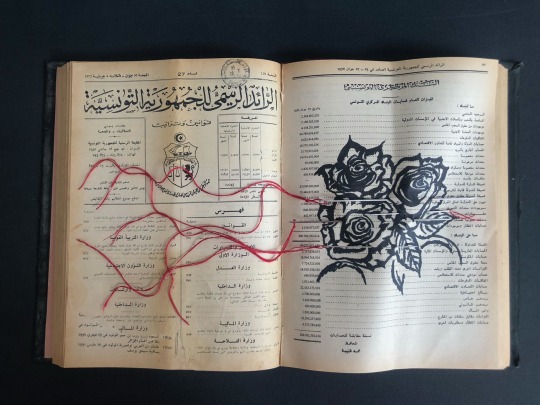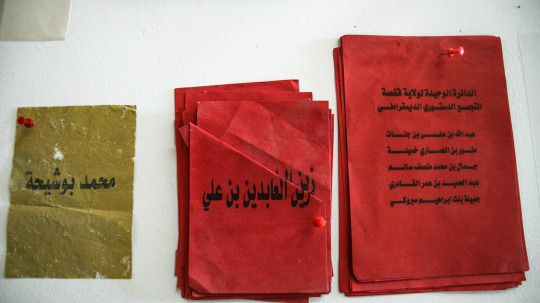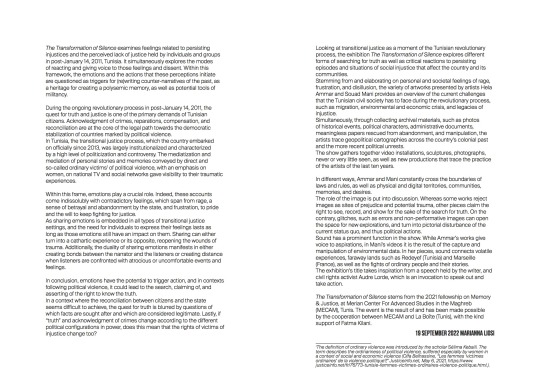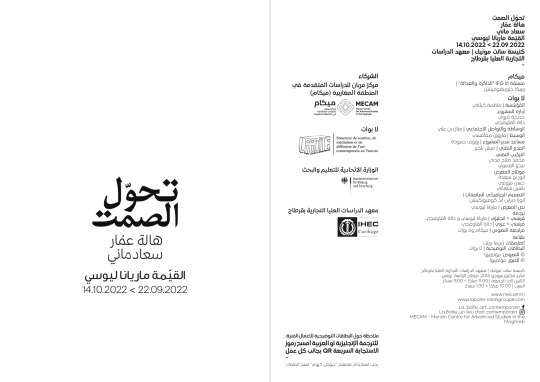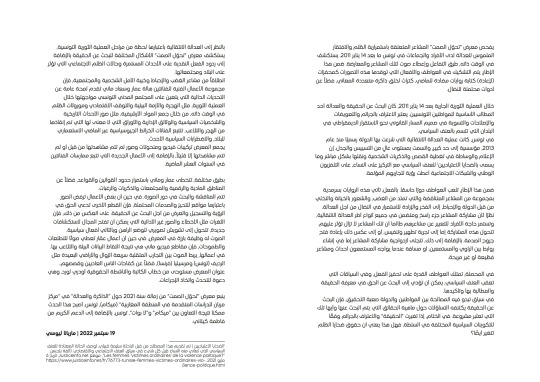Don't wanna be here? Send us removal request.
Text


eSseda.lab ال ّسدة est un espace dédié à la création, à l'expérimentation et aux échanges artistiques et académiques mêlant les arts, les sciences humaines et naturelles ainsi que les techniques.
Ce projet est le fruit d'un partenariat entre Association DELTA et l'Institut Supérieur Agronomique de Chott-Meriem à Sousse. Son objectif est de transformer un ancien grenier situé dans le site de l’institut en un lieu dont les activités sont axées sur les enjeux écologiques, les environnements numériques et biologiques. Elles abordent notamment, les questions de frontières, de paysages et de mémoires.
eSseda.lab est conçu et dirigé par Souad Mani, artiste plasticienne et enseignante. Il prend forme grâce à la collaboration scientifique et artistique entre Souad Mani, Marianna Liosi commissaire d'exposition et Wael Garnaoui, psychanalyste, tous.tes enseignant.es universitaires en Tunisie et en Europe. Le projet est devenu possible grâce au financement de Mophradat à travers son programme Self-Organization” 2023. La programmation des événements de cet espace se manifeste à travers des projections de films, des débats, des séminaires, des rencontres entre chercheurs et artistes, des résidences d’artistes, des expositions et des ateliers participatifs.
eSseda.lab est réfléchi comme un espace et une dynamique de travail transdisciplinaire, afin de favoriser la participation de son milieu composé de chercheur.se.s, d'expert.e.s, d’artistes, d'étudiant.e.s et d’activistes avec un focus sur la scène locale et une ouverture sur l’international.
0 notes
Text
Regards croisés sur des territories en transformation et des corps en déplacement
Panels, Projection de films, Installation vidéo
conçu et organisé par Wael Garanoui, Marianna Liosi et Souad Mani
Edition spéciale lancement des activités de eSseda.lab Espace situé à l’Institut Supérieur Agronomique de Chott-Meriem, Sousse

Regards croisés sur des territoires en transformation et des corps en déplacement est un programme transdisciplinaire organisé durant trois journées à l’Institut Agronomique de Chott-Meriem, dans le cadre du lancement des activités de l’espace eSseda.lab. L'événement s’inscrit dans une édition spéciale de la rencontre internationale PAYSAGES OUVERTS #3.
Au travers des panels de discussions, des projections de films documentaires, et des vidéos installations, ce programme tisse des trajectoires d’études, d’observations, d'expérimentations et de luttes de chercheurs.es, d’activistes et d’artistes de diverses disciplines avec un focus sur la zone MENA et un regard sur les relations Sud-Nord/Nord- Sud.
À travers les prismes des arts visuels, de l'architecture de paysage, de la biologie, de la psychanalyse, de la sociologie et de l'anthropologie, ce programme explore les territoires en mutation face aux changements climatiques et l'impact de l'homme sur l’environnement, ainsi que face aux politiques autoritaires et frontalières qui limitent la mobilité des individus. Ces questions critiques dans le débat international constituent le terrain de discussion et de partage de ces journées.
Regards croisés sur des territoires en transformations et des corps en déplacements est axé sur deux thématiques principales. La première est focalisée sur les traces laissées sur les paysages urbains, marins et agricoles par différentes formes de pouvoir, telles que la colonisation, l’industrie ou les pratiques destructrices des ressources naturelles. Ces empreintes sont identifiables sur le paysage par la rareté de la flore vernaculaire sous l’effet du dérèglement climatique ou envahie par des plantes coloniales introduites au pays. Elles sont visibles notamment, sur les dunes littorales occupées par l'urbanisation, une des conséquences de l’industrie et du tourisme de masse en Tunisie depuis les années 1980. Elles se manifestent par l’appropriation et le contrôle des plantes comestibles autochtones, comme c’est le cas de la Palestine, qui subit cette forme d’occupation et d’effacement de son identité. Considérées comme des traces de violences sur les paysages, ces empreintes sont devenues normalisées, pourtant elles ont marqué les communautés et les générations.
La deuxième thématique explore les corps en déplacements d’un point de vue des études des frontières. Elle examine la mobilité humaine selon la perspective des chercheur.se.s du Sud Global et ceux et celles qui adoptent une position située et engagée. Elle est développée en collaboration avec Border Studies Research Group de l'Université de Sousse, dans le but de produire un nouveau savoir sur les frontières géographiques, politiques et particulièrement sur l'immigration. Cette approche comme praxis dé coloniale met en lumière les enjeux politiques de la pensée et montre l'impact des frontières administratives et politiques sur l'imaginaire des individus en situation d'im-mobilité. Partant, d’un exemple étudié sur terrain, à savoir l'interdiction d'accès aux tunisiens à l’archipel de Kerkennah sans autorisation est un flagrant échantillon des politiques d'externalisation des frontières européennes et de leurs dispositifs de contrôle et de répression sur les populations de la rive sud de la Méditerranée.
Le dessein de ces journées d'échange est de créer une plateforme de recherche, de discussion critique et sensible autour des questions environnementales, sociales et politiques qui sont étroitement liées, ainsi que de proposer une réflexion articulée sur des méthodes d'observations et d'enquêtes, scientifiques et artistiques, augmentées par des actions collectives. eSseda.lab étale ainsi, ses champs de pratique et sa dynamique d’exister en connexion avec son milieu scientifique, culturel et économique assez fragile par rapport à sa dépendance à l’Occident.




0 notes
Text
Acts of Reciprocity
research residency in Sousse, Tunisia

Acts of reciprocity is a research residency carried out by Marianna Liosi, at the invitation of the Delta Association (Arts-Sciences-Territoires), Sousse (Tunisia).
The residency has been taking place from February 13 to March 7, 2024 between Sousse and Chott-Meriem. In coordination with Delta Association, Marianna Liosi is developing fieldwork around the following questions: What legacy and what marks of past violence are visible on the natural, agricultural, urban and marine landscape of the Chott-Meriam region and its surroundings in Tunisia? What awareness-raising actions have been undertaken by local artists, communities, and researchers, and what forms of autonomy and endurance have been activated? Within this framework, what is the role of the artist-researcher's work in Tunisia, in an insecure local and global political context?
Among the several individual and group activities, as part of the research residency, Marianna will curate three public events.
Marianna’s research residency is a preparatory phase for the co-creation of the artistic and scientific program of the eSseda.lab project space, which will officially open its doors to the public in April 2024 at the ISA in Chott-Meriem.
Acts of Reciprocity is made possible thanks to Culture Moves Europe. Funded by The European Union and Goethe-Institut.
#sousse #chottmeriem #souadmani #walidbenghezala #research #fieldwork #artresidency
Thursday 22 February 2024, 9am-4 pm
Workshop: Group walk and Rendez-vous sur l’herbe, led by Marianna Liosi and artist Souad Mani at the Landscape Architecture Department, Higher Institute of Agronomic Sciences of Chott Mariem (ISA-CM)




















Saturday 24 February 2024, 4 pm
Video screening of The Tide Will Carry Us, 2023, by Walid Ben Ghezala and discussion, at the presence of the artist (online), at De l’Image à l’Atelier, Sousse.
Walid Ben Ghezala, The Tide Will Carry Us , 2023, 19:25
Walid Ben Ghezala, The Tide Will Carry Us, 2023, 19:25 The Tide Will Carry Us follows, at nightfall, the journey of the men of a neighborhood popular area of the city of Tunis, from the alcohol depot to the seaside area. In this documentary essay, the videographer Walid Ben Ghezala recomposes in a single space-time countless hours of cassette recordings from his nocturnal wanderings. One night, on the beach of this working-class suburbs of Tunis, tongues are loosened and minds are freed, and the portrait of the of a generation, its taboos and its hopes.


Wednesday 28 February 2024, 3.30 pm
Carte Blanche Marianna Liosi | Conversation with Souad Mani (Sousse) at De l’Image à l’Atelier, Sousse.
For her second appointment at De l'Image à l'Atelier, Marianna Liosi proposes a dialogue between the artist and researcher Souad Mani that will focus on the artist's transdisciplinary and transmedia practice, between Land Art and the digital environment. The artist will talk about her most recent and significant projects and experiences, as well as her collective and relational work as a teacher and artist. Among her independent artistic initiatives, Mani will focus on De l'image à l'Atelier and the upcoming project, eSseda.lab, which have been established from the specificities of the local context of Sousse and Tunisia.
0 notes
Text
Xposures
A two-day exhibition, with performances and talks.
With: Farokh Falsafi, Asuman Kirlangic, Philipp Khan, Jeremy Knowles, Alexey Kokhanov, Rebecca Pokua Korang, Maharu Maeno, Ksenia Lapina, Carlos Ricoy, and Sepehr Talebi.
Curated by Marianna Liosi
8th and 9th July 2023, Schwartzsche Villa Berlin

0 notes
Text
Xposures is a two-day open-air exhibition and program of performances taking place in and around the garden of the Kulturhaus Schwartzsche Villa in Steglitz. The project highlights the power of collective actions in sensitising communities and propelling new ideals, as well as in protecting, questioning, and reappropriating the public domain (both urban and natural). Simultaneously, Xposures reflects upon the politics of exhibiting, and pro- cesses of re-negotiating narratives and legacies that such practices activate.
Ten emerging artists based in Berlin – from the Global South, Europe, Asia – are invited to deve- lop a rich program of site-specific interventions. The artists have been inspired by, or respond to through their individual works, the history of Schwartzsche Villa as a place of art and culture in Steglitz, the cultural heritage of the Wander- vögel archive, and the highly debated issue of the preservation of sites of former Nazi forced labour camps in Berlin, as well as the stories of inma- tes who were imprisoned. Within this framework, strategies of exhibiting, the related emotional implications, and the disclosure of underdiscussed problematic pasts are highlighted and questioned. Exhibiting creates scenarios. As performance stu- dies scholar Diana Taylor (2003) claims, scenari- os, like narratives, ‘with their own classifica- tions, categories, themes, forms and characters (...) grab the body and insert it into a frame’ (Taylor, 2003, 55) and thus place ‘the spectators within its frame, implicating us in its ethics and politics’ (Ibid., 33). Simultaneously, exhibiting itself implies the intention to unveil something, in the sense of revealing experiences, perspecti- ves, or stories. It also embeds an act of (self-) exposure – a process in which vulnerabilities and emotions are disclosed, shared and offered to ot- hers. In that sense, the ways in which objects – such as artworks, testimonies, and archives – are displayed in exhibitions, and even how bodies per- form in collective gatherings, demonstrations, and public circumstances, become political gestures of positioning.
The leading inquiries of the exhibition are: What role does the act of exhibiting (and therefore also exhibitions themselves) play in negotiating and claiming the existence and the acknowledgement of a plurality of legacies? In what ways does the exposure of bodies, archives, and emotions trigger processes of rehabilitation that involve not only artists, but also spectators?
The commissioned video and sound installations, sculptures, performances, and participatory art- works explore in various ways the politics of re- presentation of bodies, the need of decolonising memory, and the debated issue of whose legacy is transmitted through exhibitions, public memorials, repositories, visible traces in urban and digital spaces, and consequently which voices can be heard. Furthermore, the artworks reflect upon and the se- veral modes of participation of people in the com- munity life, through various forms of activisms, occupations, and mutual care. In that sense, play- ing with practices of inhabiting public and private spaces, and questioning architectures and bodies as borders between the inner and the outside, the artworks will be displayed in, and will create dialog with, the garden of Kulturhaus Schwartzsche Villa, as well as liminal spaces of the building itself (the atrium, balcony, and staircases).
Xposures is funded by Draußenstadt Fonds, SZ.
Diana Taylor (2003), The archive and the Repertoire. Performing Cultural Memories in the Americas, Duke University Press.
@xposures_openairexhibition








Photo credit: Jeremy Knowles
0 notes
Photo

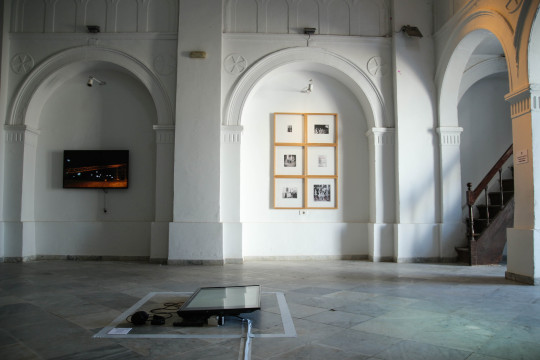



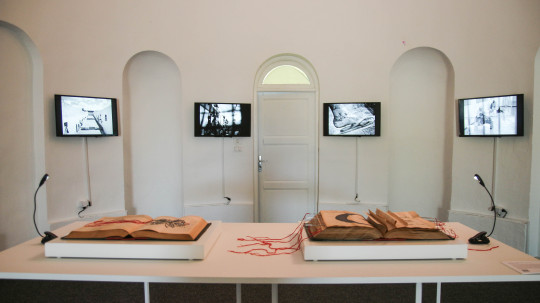



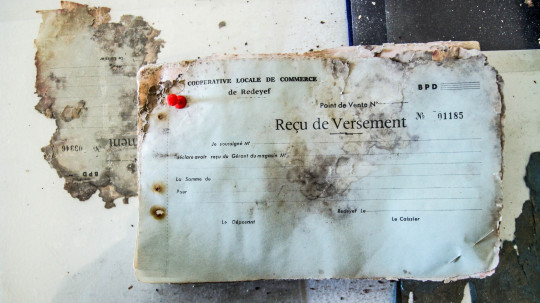
PRESS RELEASE
The Transformation of Silence
exhibition with Héla Ammar and Souad Mani
curated by Marianna Liosi
With a focus on persisting injustices in post-2011 Tunisia, The Transformation of Silence is an exhibition curated by Marianna Liosi that explores different forms of truth seeking, as well as the emotions linked to persisting social injustices that affect the country and its communities. Stemming from personal and societal feelings of rage, frustration, and disillusion, a variety of artworks by Tunisian artists Héla Ammar and Souad Mani seek to express dissent and political action. They provide an overview of the challenges that the Tunisian civil society has to face, from legacies of injustice, massive migration to severe pollution. Simultaneously, the works play as “glitches” in the current social and political system that can open the space for political change.
The show brings together performative videos, video installations, sculptures, photographs, as well as new productions and archive materials that trace trajectories through spaces, confronting historical moments and desires across times.
The title of the exhibition is inspired by a speech held by Afro-American writer, feminist, professor and civil rights activist Audre Lorde, which is an invocation to take action and speak out.
The Transformation of Silence is one of the outcomes of Liosi’s 2021 fellowship on Memory & Justice, at Merian Center for Advanced Studies in the Maghreb (MECAM), Tunis. The event is the result of, and has been made possible by the cooperation between MECAM and La Boîte (Tunis), with the kind support of Fatma Kilani.
Details:
Location: at Chapel of Saint-Monique, Rue Victor Hugo 2016, Carthage-Présidence, Tunis.
Duration of the event : From Friday 23 September, to Friday 14 October 2022.
Marianna Liosi is art curator, researcher, lecturer and cultural producer. She lives and works in Berlin. Marianna was MECAM Fellow 2021, within the Memory & Justice thematic cluster. She served as guest lecturer at the MA program Spatial Strategies at Weißensee Fine Arts Academy, Berlin (2021-2022) and as lecturer at LABA- The Free Fine Arts Academy in Rimini (Italy) (2019-2022). In 2020, she completed her PhD in Humanities, at the University of Ferrara, Italy. Her research interests focus on the question of engaged spectatorship, social networks as digital archives, affect and emotions, and digital memory as a tool of resistance. In the last years, Marianna has been focusing on education as curatorial practice. She has curated film screenings, workshops, exhibitions and she has lectured in art and academic institutions, such as HAU4, online, and MECAM’s Winter Talks #3, online (2022); European Month of Photography, Coculture, Berlin (2020); Haus der Kulturen der Welt, Berlin (2019); 00 Bienal de la Habana, Havana, Superior Institute of Fine Arts (ISBA) Sousse, Fondation Maison des sciences de l’homme, Paris, D21 Kunstraum in Leipzig (2018); Between Bridges, Berlin (2016). Marianna has published essays in artists’ books and academic edited volumes.
Souad Mani is a transmedia artist. She lives and works in Sousse, Tunisia. Her work is transdisciplinary, and it unfolds through techno-poetic experiments. In a geo-pictorial and geo-relational approach, she addresses questions about the status of the artwork, the artist and the viewer in the era of collective intelligence and interconnected objects. From photography and video to Land Art and data visualizations, Souad Mani’s works examine the possible transformations of a medium or a landscape.Her work has been exhibited at the Casa Árabe, Madrid (2021), the Biennial of Photographers of the Contemporary Arab World at the Arab World Institute, Paris (2017), and at the MuCem, Marseille (2015). She took part in various festivals in Tunisia, Spain, Italy, France, Germany, Czech and has participated in several group exhibitions in Tunisia.
Héla Ammar is a visual artist. She lives and works in Tunis, Tunisia. Besides her training in visual art, she holds a Phd in Law. Her photographs and installations address the stakes of memory. Identity and marginal communities are recurrent issues in her work. A selection of her photographs and installations is part of the permanent collection of the British Museum, London, the Arab World Institute, Paris, and the A. Slaoui Foundation’s Museum, Casablanca. Her work has been showcased in various international biennals and exhibitions such as Reflections at The British Museum, London (2021), The refugee week, featured by Shubbak Festival at the Victoria and Albert Museum, London (2019), Beyond borders at the Boghossian Foundation, Brussels (2019), Kerkennah#01, Kerkennah (2018), The Biennal of the Contemporary Arab world photographers, Arab World Institute, Paris (2017), Bamako Encounters, Mali (2017, 2015), Dak’art Biennal, Dakar (2016, 2014), Dream City, Tunis (2017, 2012, 2010).
1 note
·
View note
Photo
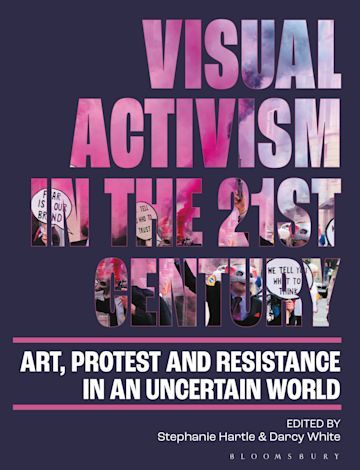
The world is in crisis, bringing activists and protesters onto the streets and into the public eye. More than ever, activism relies on spectacle and visibility in order to be noticed in the era of globalized capitalism and networked media. At the same time, a growing number of artists employ creative strategies to critique the establishment, act in resistance, and demand change. Visual activism of this kind is not new, but it is rapidly evolving. This anthology presents 16 case-studies of visual activism from across the globe, providing an up-to-date picture of the impact of contemporary visual and art activism, and combining a scholarly interrogation of visual activism with an examination of how it works in practice. The case studies address a wide range of issues including human rights abuses; state violence; gender and sexuality; racism; migration; and climate breakdown. They examine a range of approaches from playful carnivalesque parades to extreme practices such as 'lip-sewing', and are drawn from a wide range of international contexts – from Europe and the US, to Iran, India, Pakistan, Tunisia, and China. This diverse scope enables readers to consider examples comparatively – noticing emerging trends and key differences to reveal how geopolitical and cultural factors play an important role in shaping activist practices. This rich and timely collection provides a fresh perspective on the possibilities, limitations and politics of visual activism, as activists, artists, and curators respond to the changing world around them in this most uncertain of times.
Among great scholars from the Global South and North, I was honored to contribute to it with the chapter, “Montage and Vernacular Spectatorship: the Role Played by YouTube Channel AnarChnowa as a Tool of Visual Activism in Post-14 January 2011 Tunisia.”
0 notes
Photo
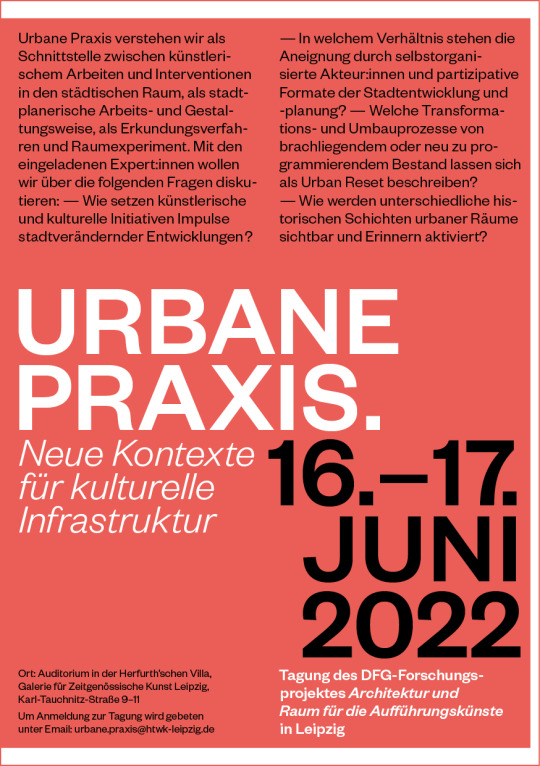

Digital commemoration and ephemeral memorials: performing the urban and online sphere
Paper by Marianna Liosi
Abstract
Through my paper, I investigate the digital sphere as a part of the public sphere. Within this framework, I will explore forms of commemoration that take place in the urban environment, and in the digital space. Questioning the permanence of memorials and its relationship with time and space, I will observe performance-based (performative) samples of memorials.
I will present two main case studies: the first is the Initiative 19. Februar Hanau, which was founded in the aftermath of the racist attack occurred in Hanau, Germany in February 2020. The initiative unfolds online through social networks and a website, as well as a widespread series of events that takes in different cities across the country.
The second consists in the performative action of Tunisian artist Souad Mani that results into the video De Mythes et de Choses. The artist illegally enters the phosphate washing plant of Redeyef, the infamous mining site in the south of Tunisia. The soundtrack of the video results from the transformation into sound of data recording high levels of pollution captured by a toolkit during the intrusion in the site.
Tracing the due differences between the types of memorials that these two cases studies embody, I will question how the digital shapes and affects the act of commemorating online and offline. Given the blurring borders between artist and militant interventions, I will analyze to what extent the digital commemoration can be interpreted as urban, and potentially activist, practice.
0 notes
Text
Digitale Raumstrategien /Digital Space Strategies
with artists: Ilghar Dadgostari, Fernanda Aloi, Jorge Baldeon, Sujatro Ghosh, Maricarmen Gutierrez, Tamara Margvelashvili, Cau Silva, Bo Xu, Karina Pino, Ricardo Sarmiento, Margarete Kiss and Leon Lechner, Hoayun Chung, Jongbin Park, Jae-Pyung Park, Marina Resende Santos, Graham Livingston, Sujatro Ghosh.
HAU4, 27 February -3 April 2022
A cooperation between weißensee kunsthochschule berlin and HAU Hebbel am Ufer.
The “Spatial Strategies” course at the Weißensee School of Art is concerned with artistic practice in urban space. Prof. Nasan Tur and Dr. Marianna Liosi have used the socio-political experiences under difficult circumstances, such as the pandemic, to develop a seminar series that considers digital space as part of the public sphere. In light of the capitalist structures of the internet, they ask whether and how artistic practices can overcome economic, gender and infrastructural barriers. What role does the audience play in this? What does artistic work in digital space mean if we assume that the public needs individual and collective care?
The individual or collective works presented at HAU4 take up a wide range of current questions. They are about personal and communal vulnerability as a trigger for social change, the potential and limits of digital space in addressing individual and societal memory and loss, the deconstruction of care within hierarchical structures, and the democratic accessibility and ecological sustainability of digital infrastructures. The proposed projects aim to reflect on the political transformations we can initiate in the public sphere in order to contribute to its permanent change.
Within the framework of the five-month cooperation, project ideas have emerged that the students present on the research platform HAU4. They show performances, text, video and sound material as well as social media interventions.
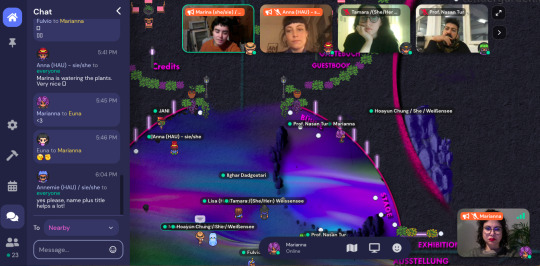
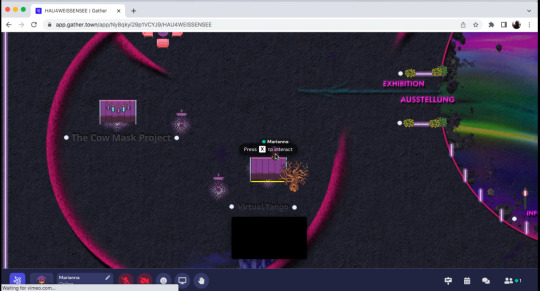
Digital Space Strategies, HAU4
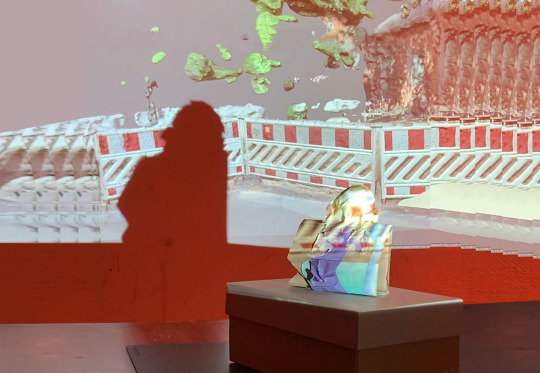
Jongbin Park, Jae-Pyung Park, Lost Ghosts, 2022, video (still frame). Courtesy: the artists
0 notes
Photo
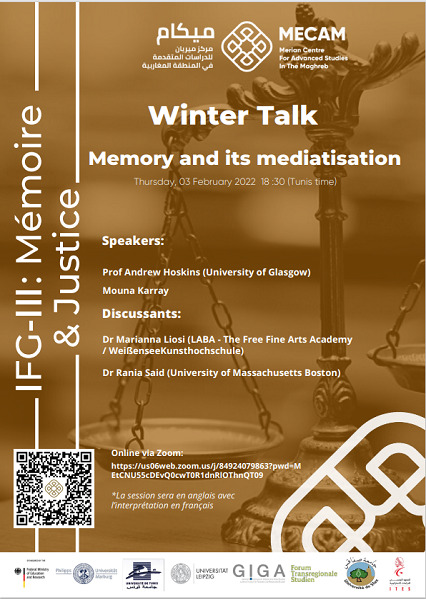
WINTER TALK: Memory and its mediatisation
What are the potentials and the challenges of mediatizing memory? What futures can mediatised memory promise? Through a reflection on collective memory and its limits, this panel is both an attempt to answer these questions from a theoretical and artistic perspective, and also an invitation to reflect on the role played by media in the ethics of documenting, forgetting and re-narrating the past.
The Winter Talk takes place online via Zoom on Thursday, 03 February 2022, 18h30 – 20h00 (Tunisian and Central European time).
Guests:
Prof. Andrew Hoskins (University of Glasgow) and Mouna Karray participate in this panel as guest speakers and Dr Marianna Liosi (Weißensee Kunsthochschule Berlin / The Free Fine Arts Academy in Rimini) and Dr Rania Said (University of Massachusetts Boston) as discussants.
0 notes
Link
Abstract:
“This article is a reflective text by an art curator interested in exploring the boundaries between video activism, spectatorship, and pedagogy. It proposes new ways of critically understanding the terms “activist,” “participation,” and “militancy” in the context of an expanded notion of the image and the role of the spectator. Emerging from field notes, the article narrates and shares the experiences of engaging students at workshops for “Between Broadcast – a project around activist videos,” held at at fine art academies and universities in Leipzig, Düsseldorf, and Bergamo. The practical aim of the workshops was to introduce and engage students with the subject of so-called activist video clips on YouTube. The students were asked to find, select, and discuss militant videos and, subsequently, to create a montage from them. The conceptual aim of the workshop was to reflect upon video spectatorship online and what that means, the agency of the spectator, and the possibilities of their active participation in the process of viewing. The outcomes of the workshops were the development of critical thinking of the students concerning the subjects of online video, digital empathy, their engagement with videos as individual viewers and as a collective, and the power of montage as a narrative and activist tool”.
Marianna Liosi
Video Journal of Education and Pedagogy, https://doi.org/10.1186/s40990-018-0024-0
© The Author(s) 2018
0 notes
Text
Between Broadcast-Workshop (2016-ongoing)
“Between Broadcast - Workshop” is an ongoing laboratory for discussion and creation at universities, conceived and curated by Marianna Liosi, which started in November 2016. It stems from "Between Broadcast - a project around activist videos" originally initiated by Marianna Liosi in collaboration with Between Bridges, in June 2016 at Between Bridges, Berlin. The project was meant to explore the bond between militancy through videos, empathy and digital memories as well as the activism of the spectator-user through montage. "Between Broadcast - Workshop" adresses to students and is intended to question what activist videos mean, and the empathic relationship that viewers establish with them, especially those found on YouTube. The project aims also to stimulate the students to a survey of the individual’s memories: a recollection of historical episodes that one can remember thanks to the online clips consumed on YouTube, able to shape the individual’s memories of those events, and in doing so, that have become travel companions over time.
“Between Broadcast - Workshop” took place variously at the Institut Supérieur de Beaux Arts, Sousse, Tunisia (2018); as part of the seminar "Creative Writing and Storytelling", held by Marianna Liosi, at the University of Potsdam, Germany (2018); at Hochschule für Grafik und Kunst Leipzig, Germany (2017), as hosted by the Expanded Cinema class of professor Clemens von Wedemeyer (November 2017); at the Academy of fine Arts in Bergamo, Italy in the Sound Design class of professor Riccardo Benassi (February 2017); at Kunstakademie Düsseldorf, Germany (2016), as an extra workshop over the winter semester.
Background:
“Between Broadcast” started in response to “Meeting Place” an umbrella of weekly events launched by photographer Wolfgang Tillmans at Between Bridges in April 2016 that ran in parallel to his EU Referendum campaign (a project conceived in response to the UK’s Brexit vote of June 23rd, 2016, which consisted of a counter campaign of anti-conservative propaganda posters plastered in the streets of several British towns). Within this framework, “Between Broadcast - a project around activist videos” was conceived as a one-month long series of public events. It started with the creation of a playlist of clips recently uploaded on YouTube, and it was collaboratively initiated together with Between Bridges team members (http://www.betweenbridges.net/meeting...) Over the course of the one-month screening of the forty-minute playlist, visitors were free to contribute to it with their own selection of videos from YouTube and were invited to deal with the same challenging investigation of their own individual memories of and through mediated images. (see: https://www.youtube.com/watch?v=XCg95...)
In November 2016, “Between Broadcast” turned into a laboratory for discussion and creation at universities.
1 note
·
View note
